It’s been two months since I started working at Collegio Miguel Merchan as a voluntary English teacher. In that timeframe, there a few things I’ve become certain of.
Firstly, teaching is not as easy as I thought. Secondly, there are elements of the Ecuadorian school system that I can never hope to understand.
And finally? I think it’s safe to say that the majority of people who spend their weekday mornings with me at Miguel Merchan are ever so slightly mad.
I’m pretty sure that we haven’t worked a full week of school since we arrived two months ago. If there’s not a national holiday at some point each week, there’s a city-wide one; and when none of those are on the horizon, there’s a school-only reason to celebrate.
For instance, a couple of weeks ago we celebrated Teacher’s Day. This involved a succession of groups of students singing on the stage in the playground, followed by a presentation in an upstairs room where we were served cool coffee, warm coke, empanadas and sanduches de pernil, all the while watching more musical acts from different groups of students.
Normal enough, right? Except I was sat beside the school nurse and watched her pour aji (Ecuadorian chilli sauce) into her empty coffee cup, then down it when she thought nobody was looking.
Five minutes later, she knocked back her small glass of white wine, presented to all of us for the purposes of a toast, and then told the woman handing out the glasses that she hadn’t yet been given one. Sneaky trick, nurse Elisabeth.
Introducing Fiesta Patronales
But the biggest “lets-not-have-classes-for-a-while” event occurred last week. Fiesta patronales is something that every school in Ecuador celebrates annually; and apparently the original Miguel Merchan decided to found a school in Cuenca at the end of April.
Cheers for the three day party, buddy.
The first we heard about it was a good month ago, when Gladys, a fellow English teacher, hung on my arm in the staff room and asked me plaintively if I’d help her write out a string of fables in English – “for the fiesta!”. We don’t get alerted to these celebrations until they’re literally about to happen, and so I had no idea what fiesta she was referring to. But I agreed regardless.
Fast forward a few weeks to me and Issy sitting in the staff room, patiently trying to explain the nuances of the English language to a group of fourteen year olds.
“It’s not ‘arro-gens’, it’s ‘arro-gance’. Entienden?”
A quick glance at the row of furrowed brows in front of us, and the growing realisation that no, they didn’t understand. I didn’t know if this was actually a problem, though. We’d had a hard enough time attempting to convince Gladys that her so-called “The Rabbit and the Turtle” fable actually had a much more common title in England. She was having none of it.
Party preparations
The day before the fiesta kicked off, I was led to a small room where the fables were to be performed; under the guise of a puppet show, no less. Maria Luisa led me eagerly to a table piled high with mounds of handmade ‘puppets’, all of which had been collated from a school-wide homework assignment.
A large number of the colourful 2D animalistic creations were clearly store bought, and others were woefully inadequate – but when Maria Luisa told me to put the worst ones in a bin bag, I felt terrible. Despite being assured that they’d be recycled in some capacity.
And the rest of that school day didn’t fill me with great hope for what fiesta patronales was going to offer.
Despite various groups of students hard at work in various corners of the school, practicing dance routines, trying on outfits and putting the finishing touches to paper-based animal sculptures, I figured it’d end up like the Founder’s Day celebrations I had at school in England, where most students found a way to quietly disappear for the day and the major audience were groups of happy parents.
I couldn’t have been more wrong.
It turns out that Ecuadorians, both kids and adults alike, absolutely adore a party. And however unconcerned they pretend to be, when they’re called to perform they do so with a crazy amount of enthusiasm.
I’m talking traditional dancing, outlandish costumes, multiple singing performances, classrooms filled with intricately made models, hours spent cooking every possible Ecuadorian foodstuff – and all topped off with a firework display that would have Health and Safety companies the world over gnawing at their fingernails.
An outlandish English presentation
But first off was the long awaited puppet show, played to a packed audience; tempted, no doubt, by the promise of countless bags of popcorn at the front door.
I assume it was payment for spending ten minutes of their precious party day sat inside watching an English puppet show.
And, thankfully, a vast majority of the homemade puppets had also been used to decorate the walls of the room. No saddened students today, at least!
Wandering around the school afterwards with Sam and Issy, the other volunteers at my school, was blissfully bizarre. Because nobody had actually informed us what the fiesta was going to entail, the surprises never stopped coming. After spending a while watching the various singing and dancing in the playground, we headed off to different classrooms, and discovered that each class had worked on a particular theme to present on fiesta day.
Sadly, some weren’t as great as others – like the science room (pockets of bored looking children in lab coats) and the cow room (covered in black and white spots, and featured a nasty aroma of sour milk) – but there were some definite winners too.
Like my favourite class, who’d dressed up as waiters and waitresses, and transformed their room into a restaurant in order to present “The Year of the Quinoa”. They served us platefuls of at least twelve different foodstuffs which, surprisingly enough, all involved the superfood.
Sadly, none of them were that super – we had to make a quick run for it.
It’s nice to be recognised!
And it was lovely realising how many of the kids actually know who we are; as me, Sam and Issy walked around, there were constant cries from various students to buy what they had on offer. I think there may have been some kind of competition going for which class could make the most money.
Regardless, I was cajoled by most of my students into buying a vast array of bizarre foods, including a blackberry ice, ground up maize in a palm leaf and a cup of lukewarm white liquid with chocolate balls floating in it.
Photo worthy, perhaps, but not so good for the palette.
Sam was also gifted with a banana by his least favourite class – who had decided to turn their classroom into a circus arena, complete with completely inexplicable food pyramid taking centre stage.
Next on the bizarre list; our resident insane gym teacher gave us a lime. We still don’t know why. This was also accompanied by a selection of wonderfully trashy rings, and brings my total of presents from the gym teacher up to five. Basically I receive at least one gift a week that he pulls out from his deep pockets.
Pretty sure he loves me.
Standing in the playground with the gym teacher also meant we had prime viewing positions for the next part of the celebrations.
Dancing in the playground
A constant turnover of dances and presentations; from a group of girls strutting down an imaginary smoke-laden catwalk wearing butterfly wings, to a group clad in fifties dresses and whirling their skirts to the tune of “You’re the One That I Want” from Grease.
Finally, the cultural stuff really kicked in – made all the more enjoyable for me when I realised that a majority of my students were performing.
It was around about then that I finally realised how intrinsic dancing is to Ecuadorian culture. In that, out of around eight hundred high school students, not one of them seemed at all embarrassed about dancing in front of their teachers and peers.
Not even when wearing bright pink ponchos and furry leg warmers.
But when you get to dance with rainbow headscarves wound about your person, there’s really no need to feel anything other than an innate sense of how awesome you look.
And of course I eventually got dragged into the proceedings. Ever since my horrific dancing moment at a village wedding in India, I’ve sworn to take the challenge when it comes – particularly when my students invite me to do it. Although I didn’t have the skirt to brandish about, so clearly that was why I look just a tad out of place.
No other reason at all.
A quick auctioning process of various plates of pre-cooked cuy (guinea pig, for those not already aware) later, and out of nowhere emerged three giant wire structures, all with fuses protruding at various angles. An immediate hint that there was about to be one hell of a firework display, placed dangerously near to a great number of children.
Foundation fireworks
We’d already had a slight indication that the students and staff of Miguel Merchan were keen on pyrotechnics. During one of the earlier dance numbers, a kid from one of my classes suddenly appeared with a cardboard cow on his head, cavorting around the playground as it smoked and sparked, littering the ground with clumps of orange embers.
Without any word of warning to the myriad of students milling about, extremely close to said firework-laden structure.
So when the bangs and whistles kicked off, and a heck of a lot of sparks started spewing forth into the surrounding air, we were expecting a bit of drama. But clearly the only sense of trepidation stemmed from the three English kids in the centre row; holding back semi-serious screams as we watched the fireworks spinning.
When in Rome…
That firework display pretty much encapsulates everything I’ve learnt about Ecuador thus far. Despite our certainty that it wasn’t safe, nobody else seemed to give it a second thought; in fact, people barely paid attention to the fireworks in general.
They were more concerned with dancing, and gossiping, and checking out the plates of cuy they’d just won.
Despite enjoying the time I spend teaching at Miguel Merchan, I’ve got to admit that watching the people I’ve known for two months in their natural state – not attempting to learn English, not trying to look cool, but simply doing what they enjoy – was infinitely better. Which is a lesson in itself, really; because who would’ve thought I’d learn the most about Ecuadorian culture from a group of high school children?


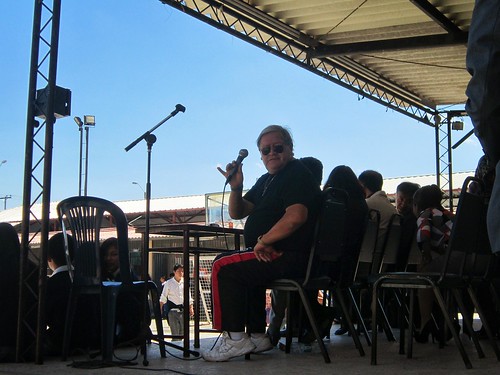


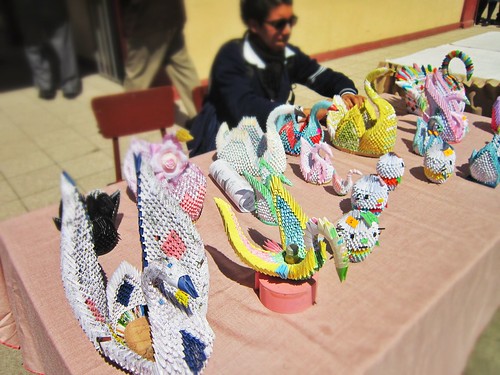
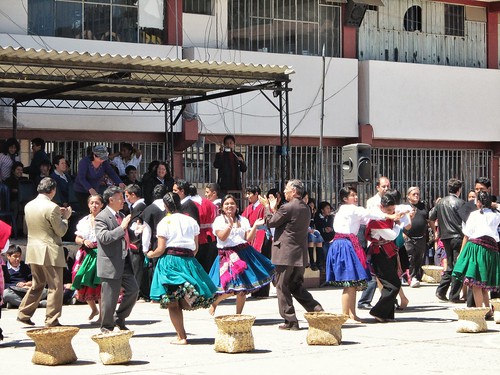





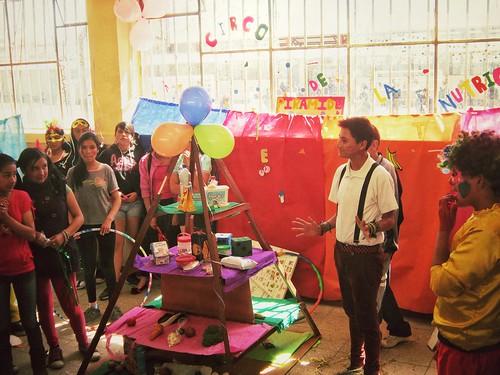
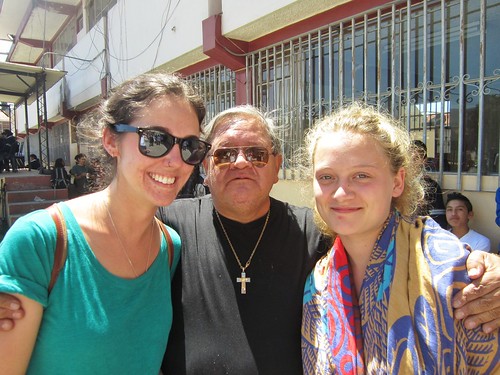

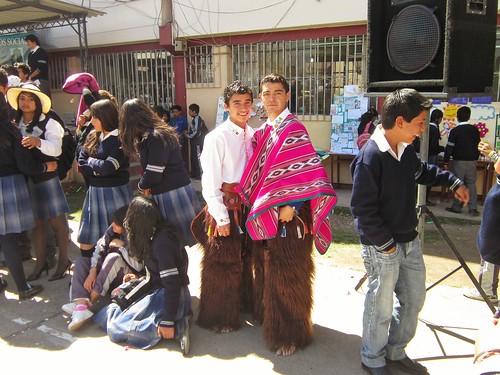


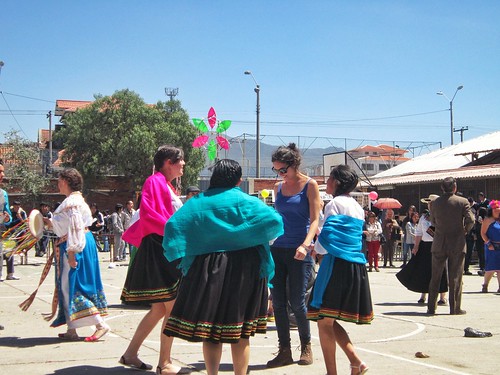
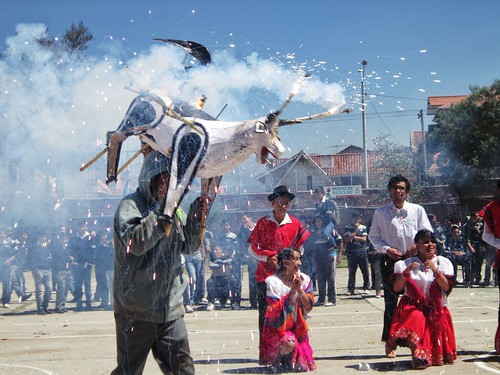
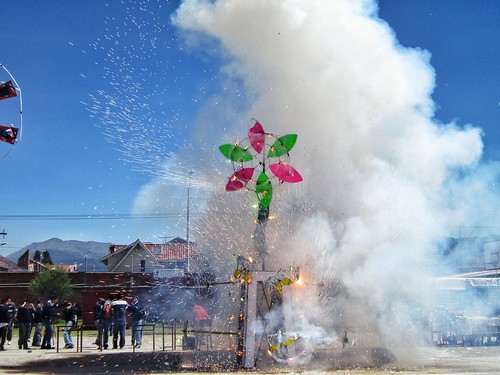
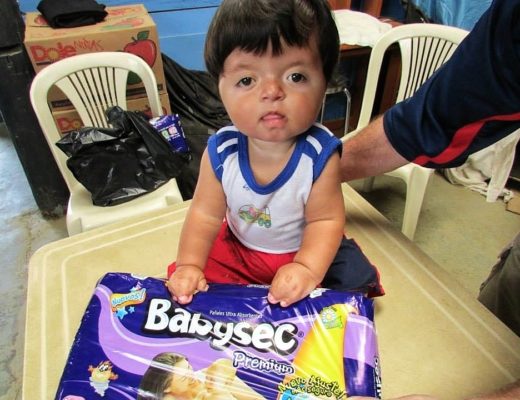


2 Comments
Ceri
June 14, 2013 at 3:06 pmThere’s nothing like a fiesta. ::D Sometimes I feel like Brits are way too reserved to do anything this amazing. I guess that’s why we feel the need to drink a lot.
BTW, Juan Naranja IS indeed the best name in Latin America!
Flora
June 17, 2013 at 3:50 amI’ve got at least another year in this crazy continent but I”m pretty damn sure I’ll never find as good a name as Juan Naranja 😛